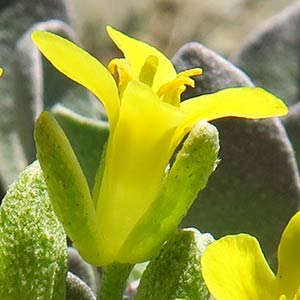|
alpine twin-pod, Washington bladder-pod, Washington twin-pod
|
Newberry twinpod, Newberry's twinpod
|
| Perennials; caudex usually simple, rarely branched, (cespitose); (silvery) pubescent throughout, trichomes several-rayed, rays (1- or) 2-bifurcate, (low-umbonate, tubercles relatively few, small). |
Perennials; caudex simple or branched, (branches often covered with persistent leaf bases, cespitose); densely (silvery) pubescent, trichomes rays fused at least 1/2 their length. |
several from base, decumbent to ascending, (unbranched), 0.5–1.5 dm. |
several from base, ascending to erect (arising laterally, unbranched), 0.5–1(–2.5) dm. |
(petiole slender); blade obovate, 3–5 cm (width 10–20 mm, base tapering abruptly to petiole), margins entire, (apex rarely slightly acute). |
(ascending to erect, petiole slender); blade oblanceolate to obovate, 3–8 cm, (base tapering to petiole), margins incised or dentate with broad teeth, (apex acute to obtuse). |
blade oblanceolate, 0.5–1.5 cm (width 3–5 mm), margins entire. |
blade linear-oblanceolate to oblanceolate, 1–2 cm, margins entire. |
subcorymbose. |
dense (elongated or not in fruit, 2.5–8.5(–10) cm). |
sepals oblong, 8–10 mm; petals spatulate, 12–14 mm. |
sepals (greenish yellow), lanceolate, 6–8.5 mm, (saccate and cucullate); petals spatulate to narrowly oblanceolate, 7–10(–12) mm. |
(divaricate, straight), 5–10 mm. |
(divaricate, straight), 5–11(–15) mm, (rigid, fruits not pendent on arching pedicels). |
didymous, mostly highly inflated (strongly flattened at least in 1/2 toward replum), 14–18 × 14–18 mm, (papery, basal sinus slightly notched, apical open, shallow); valves (retaining seeds after dehiscence), evenly pubescent; replum lanceolate, 7–10 mm, width 1.5–2.5 mm, as wide as or wider than fruit, apex acute to acuminate; ovules 8–10 per ovary; style 5–7 mm. |
didymous, sides curved and angular, highly inflated, 6–16 × 8–12 mm, (papery, apical sinus broad and concave); valves (retaining seeds after dehiscence, distinctly 2-keeled on side away from replum), pubescent, trichomes appressed; replum linear to linear-lanceolate, as wide as or wider than fruit, apex acute; ovules 4–8 per ovary; style 2–9 mm, (usually not exceeding sinus). |
flattened, (2–3 mm). |
slightly flattened, (ovate). |
= 48–52, 52, 64, 67–70. |
|
|
|
|
|
| Flowering May–Jun. |
|
| Alpine scree, rocky ridges, talus slopes, volcanic sands and gravel, serpentine gravel, granitic slopes, mountain shrub, subalpine fir, and whitebark pine communities |
|
| (700-)1300-2400 m ((2300-)4300-7900 ft) |
|
|
WA
|
AZ; NM; NV; UT
|
|
Subspecies 2 (2 in the flora). Physaria newberryi, with its unusual fruits, can be confused with 15. P. chambersii. In P. chambersii, the sides of the fruit are flat, the style always exceeds the top, or shoulders, of the fruit, and shoulders form an angle that does not curve in toward the style. In P. newberryi, the sides of the fruit are concave, the styles are shorter than shoulders of the silicle (except in subsp. yesicola), and shoulders of the silicle form a curved, inward arching crown on the fruit. (Discussion copyrighted by Flora of North America; reprinted with permission.) |
|
|
| FNA vol. 7, p. 624. |
FNA vol. 7, p. 652. |
| Brassicaceae > tribe Physarieae > Physaria |
Brassicaceae > tribe Physarieae > Physaria |
P. acutifolia, P. alpina, P. angustifolia, P. arctica, P. arenosa, P. argyraea, P. arizonica, P. aurea, P. bellii, P. brassicoides, P. calcicola, P. calderi, P. carinata, P. chambersii, P. cinerea, P. condensata, P. congesta, P. cordiformis, P. curvipes, P. densiflora, P. didymocarpa, P. dornii, P. douglasii, P. eburniflora, P. engelmannii, P. eriocarpa, P. fendleri, P. filiformis, P. floribunda, P. fremontii, P. garrettii, P. geyeri, P. globosa, P. gooddingii, P. gordonii, P. gracilis, P. grahamii, P. hemiphysaria, P. hitchcockii, P. humilis, P. integrifolia, P. intermedia, P. kingii, P. klausii, P. lata, P. lepidota, P. lesicii, P. lindheimeri, P. ludoviciana, P. macrocarpa, P. mcvaughiana, P. montana, P. multiceps, P. navajoensis, P. nelsonii, P. newberryi, P. obcordata, P. obdeltata, P. occidentalis, P. oregona, P. ovalifolia, P. pachyphylla, P. pallida, P. parviflora, P. parvula, P. pendula, P. pinetorum, P. prostrata, P. pruinosa, P. pulvinata, P. purpurea, P. pycnantha, P. rectipes, P. recurvata, P. reediana, P. rollinsii, P. saximontana, P. scrotiformis, P. sessilis, P. spatulata, P. subumbellata, P. tenella, P. thamnophila, P. tumulosa, P. valida, P. vicina, P. vitulifera |
P. acutifolia, P. alpestris, P. alpina, P. angustifolia, P. arctica, P. arenosa, P. argyraea, P. arizonica, P. aurea, P. bellii, P. brassicoides, P. calcicola, P. calderi, P. carinata, P. chambersii, P. cinerea, P. condensata, P. congesta, P. cordiformis, P. curvipes, P. densiflora, P. didymocarpa, P. dornii, P. douglasii, P. eburniflora, P. engelmannii, P. eriocarpa, P. fendleri, P. filiformis, P. floribunda, P. fremontii, P. garrettii, P. geyeri, P. globosa, P. gooddingii, P. gordonii, P. gracilis, P. grahamii, P. hemiphysaria, P. hitchcockii, P. humilis, P. integrifolia, P. intermedia, P. kingii, P. klausii, P. lata, P. lepidota, P. lesicii, P. lindheimeri, P. ludoviciana, P. macrocarpa, P. mcvaughiana, P. montana, P. multiceps, P. navajoensis, P. nelsonii, P. obcordata, P. obdeltata, P. occidentalis, P. oregona, P. ovalifolia, P. pachyphylla, P. pallida, P. parviflora, P. parvula, P. pendula, P. pinetorum, P. prostrata, P. pruinosa, P. pulvinata, P. purpurea, P. pycnantha, P. rectipes, P. recurvata, P. reediana, P. rollinsii, P. saximontana, P. scrotiformis, P. sessilis, P. spatulata, P. subumbellata, P. tenella, P. thamnophila, P. tumulosa, P. valida, P. vicina, P. vitulifera |
|
|
| Lesquerella alpestris |
P. didymocarpa var. newberryi |
| Suksdorf: W. Amer. Sci. 15: 58. (1906) |
A. Gray: in J. C. Ives, Rep. Colorado R. 4: 6. (1861) |
| |


